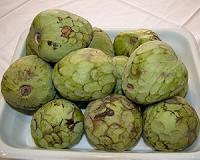 |
Perth, Australia (AFP) March 15, 2011 Australia's popular Kimberley wilderness region has resorted to a long knee-high fence to keep out the poisonous cane toad, which is rapidly overrunning the tourist attraction. A two-kilometre (1.25 mile) barrier will be erected at Emma Gorge, made from cloth to allow other animals to move through while keeping out the toads, prolific breeders which secrete a toxin that can kill pets and wildlife. Stop the Toad Foundation campaign manager Kim Hands said hundreds of thousands of toads had penetrated into the area and were threatening native species. "Experience in the past has been that it has been really efficient," she said of the fence. The cane toad has spread widely in tropical Australia since being introduced to kill beetles in the 1930s, devouring insects, bird's eggs and native species such as the quoll, a cat-like marsupial. But a recent investigation by the University of Melbourne showed that the toad -- up to 25 centimetres (10 inches) long and two kilos (4.4 pounds) in weight -- has an Achilles' heel. Unlike indigenous amphibians that have adapted to arid conditions, it desperately needs access to nearby standing water to survive. Placing small fencing around man-made sources such as irrigation ditches and troughs is enough to cause the toad to die of dehydration and stop its advance, said the study.
Share This Article With Planet Earth
Related Links Farming Today - Suppliers and Technology
 Seedless Cherimoya, The Next Banana
Seedless Cherimoya, The Next BananaDavis CA (SPX) Mar 15, 2011 Mark Twain called it "the most delicious fruit known to man." But the cherimoya, or custard apple, and its close relations the sugar apple and soursop, also have lots of big, awkward seeds. Now new research by plant scientists in the United States and Spain could show how to make this and other fruits seedless. Going seedless could be a big step for the fruit, said Charles Gasser, professo ... read more |
|
| The content herein, unless otherwise known to be public domain, are Copyright 1995-2010 - SpaceDaily. AFP and UPI Wire Stories are copyright Agence France-Presse and United Press International. ESA Portal Reports are copyright European Space Agency. All NASA sourced material is public domain. Additional copyrights may apply in whole or part to other bona fide parties. Advertising does not imply endorsement,agreement or approval of any opinions, statements or information provided by SpaceDaily on any Web page published or hosted by SpaceDaily. Privacy Statement |